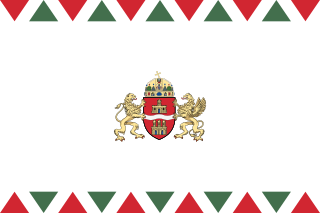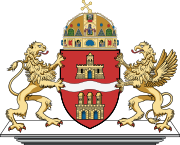| City Budapest
|
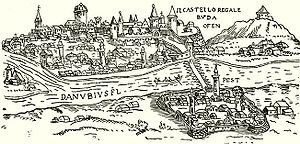
Buda and Pest, 16th century.
Hungarian parliament building
Budapest(Hung. Budapest[ˈbudɒpɛʃt] ) is the capital and largest city of the country. With a population of 1.745 million as of January 2014, Budapest ranks eighth in the European Union. The city was formed in 1873 as a result of the merger of several Hungarian cities: located on the eastern side of the Danube River, and Obuda, occupying the western bank of the Danube.
History
In the 1st century BC e. on the site of Budapest there was a Celtic settlement Ak-Ink, which was a trade and craft center. After the arrival of the Romans in 89 A.D. e. the territory was incorporated into the Roman province of Pannonia. In 106, Ak-Ink was renamed into Aquincum and made it the administrative center. The city housed the Roman garrison and there were about 20 thousand inhabitants. An archaeological park has survived to this day: the ruins of public buildings, private houses and an aqueduct. Until the 4th century, Aquincum was the capital of the province of Pannonia Inferior. The Roman II Auxiliary Legion stood in the city.
By 450, the Romans were driven out by the Ostrogoths and Huns, and Pannonia became the center of the Hunnic empire.
Modern Pest was called Contra Aquincum(Against Aquincum) and was a small settlement.
After the Huns, the city was dominated by the Avars, and then by Great Moravia.
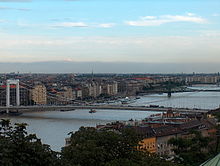
Elizabeth Bridge
Around 895, the Hungarian tribes came to the Danube, Aquincum was renamed Buda (later Obuda - Old Buda) and became the first political center of Hungary. A century later, the Hungarian state was proclaimed.
Settlers from and began to appear in Pest.
As a result of the Mongol invasion in 1241, Buda and Pest were devastated. After that, in 1247, King Bela IV built a fortified royal castle on Fortress Hill - Buda. In 1361 Buda was proclaimed the capital of the Kingdom of Hungary.
In 1473, Andras Hess printed the first Hungarian book in Buda, which was the Hungarian Chronicle.
In 1541 Buda and Pest were occupied. The decline of the city and the decrease in its population began. The residence of the Turkish pasha was located in Buda, the city was the capital of the vilayet. Only in 1686 the Buda Castle was taken by storm after almost 40 days of siege. The city was liberated from the rule of the Ottoman Empire by the Austrian troops under the leadership of Eugene of Savoy and annexed to the possessions of the Habsburgs. In the 18th century, the rapid development of Pest as a trading center began.
By 1800, the population of Pest exceeded that of Buda and Obuda combined. In the next century, the population of Pest grew 20 times and amounted to 600 thousand people, while the population of Buda and Obuda grew only 5 times. The unification of the three cities was first undertaken during the revolution of 1848-1849. However, the restoration of the Habsburgs after the defeat of the revolution again led to division. The final unification of the three cities into one under the name of Budapest took place on November 17, 1873 after the formation of a separate Hungarian royal government (Austro-Hungarian Compromise). The city began to develop rapidly. In 1896, a large-scale celebration of the 1000th anniversary of the acquisition of the Motherland by the Hungarians took place in Budapest. In 1900, the population of the united city was 730 thousand people.
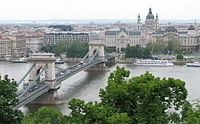
View of the Szechenyi Chain Bridge from the slopes of the Buda Mountains
In the middle of the 19th century, Hungarian railways began to develop. From Buda and Pest, the lines diverged in all directions - to the North, to the Balkans and the Carpathians.
In 1873, the streets of the city began to be illuminated with electric lamps, in 1887 trams appeared in the city, in 1885 - a city telephone, and in 1896 - the first metro on the European continent.
In 1918 the country was proclaimed, in 1919 - a Soviet republic. Then Admiral Miklós Horthy, who was declared regent, came to power in Hungary. At the beginning of the 20th century, the main population growth took place in the suburbs, such as Ujpest and Kishpest. By 1930, the population of the city was about 1 million people, and the population of the suburbs was about 400 thousand. After Horthy was removed from power, in March 1944, Budapest was occupied by German troops.
Most of the Jewish population of Budapest (250 thousand people before the occupation) was destroyed during the Holocaust. There is a well-known story of the Swedish diplomat Raoul Wallenberg, who saved many Jews in Budapest.
Later, the city was besieged by the Red Army, the siege lasted 102 days, the central districts of the city turned into ruins during the fighting. On February 13, 1945, Budapest was stormed by Soviet troops. During the assault, the German troops blew up all the bridges. After the end of the fighting, a quarter of all buildings in Budapest were in ruins. About 38,000 people died in this battle.
In the post-war period, on January 1, 1950, the area of the city was significantly expanded. Greater Budapest was formed. The restoration of the city continued in 1950-1960. During the uprising in October 1956, Soviet troops entered Budapest,
In September-October 2006, mass anti-government demonstrations took place in Budapest. These unrest were provoked by the publication of a speech by Ferenc Gyurcsany, Prime Minister of the newly elected government of Hungary from the Hungarian Socialist Party, in which, at a closed meeting of the faction, he admitted the manipulation of data on the economic situation before the elections in the spring of 2006.
In Europe, the center of both the pornographic film industry and the sex industry in general is Budapest.
Demographic history

Population of Budapest
Population:
- 1780: 48,000 (Buda: 27,000, Pest: 21,000)
- 1804: 59,610 (Buda: 30,784, Pest: 28,826)
- 1830: 98,493 (Buda: 37,973, Pest: 60,520)
- 1847: 133,096 (Buda: 41,974, Pest: 91,122)
- 1869: 270 476
- 1890: 486 671
- 1900: 733,358 (Industrialization)
- 1910: 880,371 (756,070 Hungarians, 78,882 Germans, 20,359 Slovaks...) (1910 - census)
- 1930: 1 006 184
- 1941: 1 164 963
- 1945: 907 774 (Budapest operation, Holocaust)
- 1949: 1 057 912
- 1950: 1,590,360 (Greater Budapest)
- 1980: 2,059,226 (Urbanisation)
- 1990: 2 016 681
- 2001: 1,777,921 (1,631,043 Hungarians, 18,097 Germans, 14,019 Gypsies, 4,929 Slovaks…) (2001 - Census)
- 2005: 1 695 814
- 2008: 1,702,297 (Buda: 480,756, Pest: 1,221,541)
- 2014: 1 744 665
Geography
Geographical position
Budapest is located in the low Carpathian Basin, bordered by the Carpathians, the Alps and the South Slavic mountain ranges. The Danube divides the city into two parts: hilly and green Buda (right bank, western) and flat. The highest point of Budapest is Mount Janos, belonging to the Buda Mountains, with a height of 527 m. From a geotectonic point of view, Budapest is located at the fault site, which explains the presence of numerous thermal springs that brought the city fame as a resort.
Islands
Within Budapest, there are seven islands on the Danube: Hayodyari Sziget, Margaret and Csepel (part of district XXI), Palotai (actually a peninsula), Nepsiget, Harosh Sziget and Molnar Sziget are part of districts III and XIII.
Margaret Island
Margarita Island is named after the daughter of King Bela IV - Margarita (in Hungarian - Margit). The island has a length of 2.5 km and an area of 0.965 km². The main part of the island is occupied by a park and health facilities. The island is located between the bridges of Margaret (in the south) and Arpad (in the north). The island has a water park, a fitness center, bike paths, a mini zoo, a dancing fountain, and other places of entertainment. In the 13th century, a monastery of the Dominican order was founded on the island, where Margit labored. Margit was canonized under the name of St. Margaret.
Later, the island fell into disrepair, and only in the 18th century a palace was built on the island, and the island itself was planted with rare species of trees and flowers. The ruins of the monastery and the chapel have survived to this day.
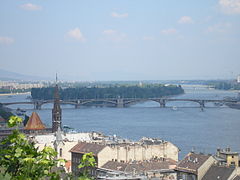
Climate
The climate of Budapest is temperate continental. Winters are very mild and short, summers are relatively long and hot, but usually without extreme temperatures. Frosts are usually short and not very strong.
| Climate of Budapest (normal 1981−2010) | |||||||||||||
|---|---|---|---|---|---|---|---|---|---|---|---|---|---|
| Indicator | Jan. | Feb. | March | Apr. | May | June | July | Aug. | Sen. | Oct. | Nov. | Dec. | Year |
| Absolute maximum, °C | 17,7 | 18,8 | 25,0 | 30,7 | 33,5 | 36,3 | 40,7 | 39,4 | 34,4 | 29,0 | 20,4 | 19,3 | 40,7 |
| Average maximum, °C | 2,6 | 5,0 | 10,6 | 17,1 | 22,4 | 25,3 | 27,9 | 27,4 | 22,1 | 16,1 | 8,5 | 3,2 | 15,7 |
| Average temperature, °C | −0,4 | 1,4 | 6,0 | 11,8 | 16,8 | 19,8 | 22,0 | 21,5 | 16,6 | 11,1 | 5,1 | 0,5 | 11,0 |
| Average minimum, °C | −2,9 | −1,7 | 2,1 | 6,8 | 11,5 | 14,5 | 16,4 | 16,0 | 11,8 | 7,1 | 2,3 | −1,6 | 6,9 |
| Absolute minimum, °C | −22,2 | −18,6 | −14,8 | −3,6 | 0,0 | 3,9 | 8,3 | 6,0 | 0,0 | −6,5 | −13,4 | −17,3 | −22,2 |
| Precipitation rate, mm | 35 | 28 | 33 | 40 | 59 | 70 | 51 | 56 | 43 | 36 | 50 | 41 | 542 |
| Source: "Weather and Climate" | |||||||||||||
Administrative division

Map of districts of Budapest
- District I is a small part of central Buda (eastern), including the Buda Castle.
- District II - also part of Buda (northwest)
- District III - extends along the northern part of Buda
- District IV - located in Pest (in the northern part)
- District V - located in the very center of Pest (historical districts of Belváros and Lipotváros)
- Districts VI, VII, VIII and IX - districts east and south of the center of Pest
- District X - further east, also in Pest
- Districts XI and XII - located in Buda, south and west of District I (fortress).
- Districts XIII, XIV, XV, XVI, XVII, XVIII, XIX and XX (mostly the outer parts of the city) - form a semicircle around central Pest
- District XXI - extends in the direction of the Danube (the northern tip of Csepel Island) to the south
- District XXII - located in the southwest of Buda
- District XXIII is the southern outskirts of Pest
Transport
Air Transport
Budapest Ferihegy International Airport has 3 passenger terminals (1, 2A and 2B). The airport is located to the east of District XVIII. The airport was opened on May 7, 1950. At first, the length of the runway was 2500 m, and in 1961 it was increased to 3010 m. In 1985, a new terminal was opened and a second runway with a length of 3706 m was built. Since 2011, the airport has been named after Franz Liszt.
Ground transport
Motor transport
Hungary's main highways lead to Budapest. Of the four motorways and four highways (except the eighth), seven start in Budapest. Road signs are the same as road signs in all other EU countries. Intercity buses arrive at the Nepliget bus station, Arpad Bridge and Etele Square in Buda. Between 1990 and 1994, city streets were renamed, the names that had existed since the end of the 19th century were returned. During the communist regime, many streets had ideological names.
City public transport
Basically, public transport in Budapest is owned by BKV. The public traffic network consists of 180 bus routes, 14 trolleybus routes, 29 tram lines and four metro lines. Three metro lines (1, 2 and 3) intersect at the Deak Ferenc ter station. The Budapest metro is the oldest on the European continent. The first line was laid under Andrássy Avenue from Vörösmarty Square to Heroes' Square. This line is still in operation (yellow line - Vörösmarty Square - Mexico City Avenue). Antique-styled trains run along the line. Other lines use Russian-made trains (Mytishchi plant) and Alstom.
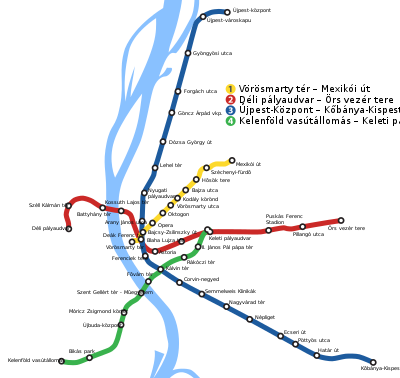
Scheme of the lines of the Budapest metro
The tram lines in Budapest are the busiest in the world. Rush hour interval is 60 - 90 sec.
Budapest uses the longest trams in the world - articulated low-floor Combino Supra trams. The length of one such tram is 53.9 meters. A total of forty such trams were ordered.
Special transport includes a funicular, a cog railway and a children's railway. The Buda funicular "Shiklo" rises from the foot of the hill, from Adam Clark Square at the Chain Bridge to the fortress. The length of the path is 100 m. The difference in height between the lower and upper stations is 48 m. The funicular was built on the initiative of Count Eden Széchenyi and put into operation on May 2, 1870. Initially, the wagons were powered by a steam engine.
Railway
Rail transportation is carried out mainly by the Hungarian State Railways (MÁV). There are three railway stations in Budapest: Keleti East Station, Nyugati West Station and Delhi South Station. The Nyugati station building was designed by Gustav Eiffel. Budapest was one of the main stations of the Orient Express. In addition, there are HÉV commuter trains.
In Budapest, there is also a children's railway, built in 1948.
Water transport
The Danube flows through Budapest - one of the main water arteries of Europe. The river is navigated. There is a trading port on the island of Csepel.
In Budapest itself, recreational water transport is developed. River trams of the "Moscow" type of Soviet production are quite common.
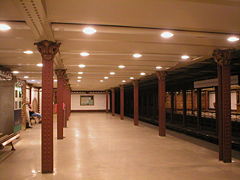
Attractions
The sights of Budapest on the banks of the Danube, the Buda Castle and Andrássy Avenue are included in the UNESCO World Heritage List.
(Points of interest are grouped by their location)Andrássy Avenue
Andrássy Avenue is the most representative street in Budapest. It connects Erzsébet Square (Erzsébet tér) with the Heroes' Square and with the Varosliget city park; there are many buildings in the neo-Renaissance style on the avenue, one of the most striking examples of which is the Opera House, which was built according to the design of the architect Miklós Ybl and opened in 1884. The construction of the avenue was started in 1872 and was completed, basically, by 1884 In 1885, the avenue was named after the prime minister and foreign minister of Austria-Hungary, Gyula Andrássy. The avenue is included in the UNESCO World Heritage List.
The main attractions of Andrássy Avenue

National Theater (Hungarian Nemzeti Színház)
- Postal Museum (moved)
- Hungarian State Opera House
- Drexler Palace
- Franz Liszt Square
- Mora Yokai Square (Jókai Mór tér)
- Oktogon Square
- Terror Museum
- House-Museum of Franz Liszt
- Franz Liszt Academy of Music
- House-Museum of Zoltan Kodai
- Puppet Theatre
- Old palace of art
- Hungarian University of Fine Arts
- Museum of Art of the Far East
- Heroes Square
- Armenian Catholic Church
Buda Castle (Fortress District)
In this area are the Royal Palace, the National Gallery, the National Library, the Museum of the History of Budapest, Matthias Cathedral, the Fisherman's Bastion, the Labyrinth, the Plague Column, the House of Hungarian Wines and the funicular leading to Mount Janos, where the Elisabeth observation tower is located. The facade of the Royal Palace stretches along the Danube, its length is 300 m. In the southern part of the palace there is a wing of Maria Theresa, built in the Baroque style. The palace was damaged during the Second World War, after restoration the National Gallery was opened in it. Matthias Cathedral (Buda Church of Our Lady) was also damaged during World War II. Its Gothic tower and Zsolnay tiled roof and the Fisherman's Bastion are the city's most photographed landmarks. The name "Fisherman's Bastion" arose as follows: on the eastern slope of the Fortress Mountain, and along the Danube, mainly fishermen lived, hence the name of the area: "Water City". They sold their catch at the fish market, located near the Matthias Cathedral, so the bastion - the defensive structure of the fortress had to protect the fishermen's shop. The bastion was rebuilt in the neo-Romanesque style at the end of the 19th century in preparation for the festivities of the Millennium of Hungary for the rest of the townspeople.
City Park
The park contains the Szechenyi baths, the Vajdahunyad castle, a zoo, a circus, an amusement park, and an ice skating rink is open in winter. The complex of buildings called "Vajdahunyad Castle" was built in 1896, on the occasion of the 1000th anniversary of the Hungarians finding their homeland. At first it was built of wood, but the townspeople liked it so much that later, in 1904-1908. was rebuilt in stone. The complex consists of 21 copies of buildings from different parts of Hungary, representing different architectural styles, including the castle of the Hunyadi family from Transylvania, from which the complex takes its name. The Szechenyi baths (Széchenyi-gyógyfürdő) are the largest in Europe. The water comes from two hot mineral springs with a temperature of 74°C and 77°C. The baths were built in 1913 in neo-baroque style. The Budapest City Park houses a circus, a zoo, several museums and the famous Gundel restaurant.
Danube embankment
There are interesting buildings on the embankment, such as the Vigado Concert Hall, the Gresham Palace (now the Four Seasons Hotel), a statue of a girl in a carnival costume. The Vigado building is the second largest concert hall in Budapest. Designed by the architect Friedesh Fesl in 1859. The Vigado Hall was built on the site of another concert hall, the Reduta, which was destroyed in a fire in 1848. The building was seriously damaged during the Second World War. The restoration took 36 years. In 2006 the façade was restored. The Pest panorama of the Danube is included in the UNESCO World Heritage List. The Széchenyi Chain Bridge (opened in 1849) was the world's largest architectural achievement of its time.
Mount Gellert
It is worth paying attention to the baths of the hotel "Gellert", the monument to Gellert, the chapel in the cave, the Citadel and the Freedom Monument. Initially, the monument was dedicated to the liberation of Budapest by the Soviet Army. In the early 90s of the XX century, the figure of the liberator was removed from the composition.
The mountain is named after St. Gerard of Hungary (St. Gellert) (c. 977 - 1046, Budapest), who baptized the Hungarians and was killed in a barbaric way: he was thrown from the aforementioned mountain in a barrel studded with nails and drowned in the Danube. Baths "Gellert" were built in 1912-1918. in the style of the Secession (Art Nouveau). Baths include hot mineral water pools and saunas. In the outdoor pool, artificial waves are created every 10 minutes. Medical services and therapeutic massages are available.
Central Market and Freedom Bridge
The Central Market (Nagycsarnok) is located in District IX and is the largest market in the city. In the market you can find a large selection of vegetables, fruits, cheese and meat. The roof was restored and lined with Zsolnay tiles.
The Freedom Bridge leads from Pest to the foot of Mount Gellert in Buda - from Gellert Square to the building of the central market. The bridge was built in 1896 according to the design of Janos Feketehazi. Bridge - chain type. The bridge was opened in the presence of the Emperor of Austria-Hungary Franz Josef and named after him. The bridge is 336 m long and 20 m wide.
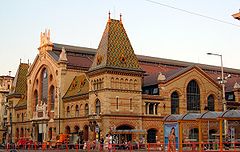
Heroes Square
Heroes' Square is one of the main squares of the city. It is located at the end of Andrássy Avenue, next to the City Park. The square is flanked by two buildings: the Museum of Fine Arts on the left and the Mucharnock Exhibition Hall on the right. There is an embassy on the square (formerly the embassy of Yugoslavia, where in 1956 the leader of the uprising, Imre Nagy, took refuge). The central part of the square is occupied by the Memorial of the 1000th Anniversary of Finding the Homeland with statues of Hungarian leaders since the 9th century and other significant figures of Hungarian history. The monument was founded in 1896 and completed in 1929. The length of the colonnades is 85 m. The height of the central column, crowned with the image of the Archangel Gabriel, is 36 m. In the center is a sculpture of the leader of the Hungarian tribes - Arpad (the work of the sculptor György Zala). On June 16, 1989, 250,000 people gathered on the square to rebury the remains of Imre Nagy (executed in June 1958).
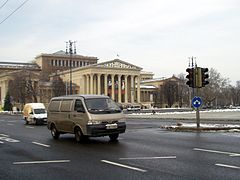
Great Synagogue on Dohany Street and Holocaust Museum
The Great Synagogue on Dohany Street is the largest in Europe and the second in the world. It can accommodate up to 3,000 worshipers. The building is 75 m long and 27 m wide. The synagogue was built in 1854-1859. in Moorish style designed by architect Ludwig Förster. The interior was designed by Friedesh Fesl. The square in front of the synagogue bears the name of Theodor Herzl, who was born in the house where the Jewish Museum of Budapest now stands.
The Raoul Wallenberg Memorial Park in the courtyard of the synagogue is dedicated to the memory of 600,000 Hungarian Jews who died during the Holocaust. In the center of the memorial there is a metal tree (weeping willow), on the leaves of which the names of the dead are engraved.

Parliament building
Seven years after the unification of Buda, Pest and Obuda, in 1880 the National Assembly decided to build a parliament building to emphasize the sovereign right of the Hungarian nation. A competition was announced, which was won by the architect Imre Steindl, but some of the ideas of the other two participants in the competition were also implemented - in the building of the Ethnographic Museum and in the building of the Ministry of Agriculture. In 1885, construction began, the first meeting of the State Assembly was held in the building in 1896, during the celebration of the 1000th anniversary of the Finding of the Motherland. The construction of the parliament was completed only in 1906. It should be noted that by the time the construction was completed, the architect of the project was blind. Thousands of people worked on the construction, 40 million bricks and 40 kg of gold were used. Like the British Parliament building, the style of the building is neo-gothic. The building covers an area of 18,000 m². The building is 268 m long and 123 m wide. Its interior includes 10 courtyards, 13 elevators, 27 gates, 29 stairs and 691 rooms. The height of the building is 96 m, it is one of the tallest historical buildings in the city. The main facade faces the Danube. On the facade there are sculptures of Hungarian kings and leaders (88 in total). The main entrance ("Lion's Gate") overlooks Lajos Kossuth Square.
View of Pest and Parliament from the Fishermen's Bastion
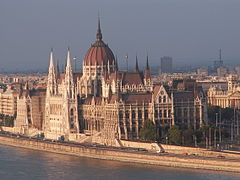
St. Stephen's Basilica
St. Stephen's Basilica (Hungarian Szent István-bazilika) is named after the first king of Hungary, Stephen. The construction of the cathedral began in 1851 under the direction of the architect Jozsef Hild. After his death, the construction of the cathedral was led by Miklós Ybl. Construction was completed in 1905. The total area of the cathedral is 4730 m², the diameter of the dome is 22 m, and the height is 96 m. Along with the parliament building, the basilica is the tallest historical building in the city. In the basilica there is a chapel with the relics (right hand) of St. Stephen and stained glass windows with Hungarian saints.
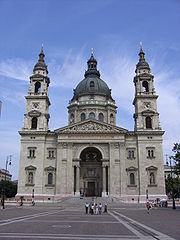
Freedom Square
Not far from the Danube embankment and the parliament building is Freedom Square (Hungarian Szabadság tér). The buildings of the Hungarian Radio and Television Company, the US Embassy and the National Bank are located on the square. In the center of the square there is a monument to the soldiers of the Soviet Army who fell during the liberation of Budapest from fascism.
Vaci street
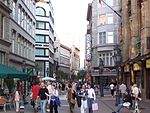
Vaci street
Vaci Street (Hungarian Váci utca) is the heart of the city. The street starts at Vörösmarty and ends at Föwam Square (near the central market). The street is full of shops and restaurants. Many building facades have cast-iron decorations and mosaics.
Museums in Budapest
- Hungarian National Museum
- Hungarian National Gallery
- Art Museum
- Museum of the History of Budapest
- Museum of Applied Arts
- Ethnographical museum
- Museum Ludwig - the best of the branches of the Cologne Museum Ludwig
- Kiscelli Museum
Budapest - resort city
Budapest is the only capital of the European state - a resort thanks to numerous hot mineral springs. Remains of Roman baths from the 2nd century have been found within the city. However, the culture of the baths began to really develop only during the Turkish invasion in the 16th-17th centuries (1541-1686). There are 26 baths in Budapest. The largest are Szechenyi, Gellert, Kiraly and Rudash.
